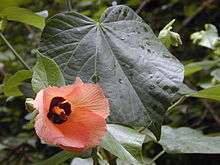- Hibiscus tiliaceus
-
Hibiscus tiliaceus 
Conservation status Scientific classification Kingdom: Plantae (unranked): Angiosperms (unranked): Eudicots (unranked): Rosids Order: Malvales Family: Malvaceae Genus: Hibiscus Species: H. tiliaceus Binomial name Hibiscus tiliaceus
L.Synonyms Talipariti tiliaceum (L.) Fryxell[2]
Hibiscus tiliaceus is a species of flowering tree in the mallow family, Malvaceae, that is native to the Old World tropics.[3] Common names include Sea Hibiscus, Beach Hibiscus, Coastal (or Coast) Hibiscus, Coastal (or Coast) Cottonwood, Green Cottonwood, Native Hibiscus, Native Rosella, Cottonwood Hibiscus, Kurrajong, Sea Rosemallow, Norfolk Hibiscus, Hau (Hawaiian), and Purau (Tahitian). The specific epithet, "tiliaceus", refers to its resemblance to the related Tilia species.[4]
Contents
Description
H. tiliaceus reaches a height of 4–10 m (13–33 ft), with a trunk up to 15 cm (5.9 in) in diameter.[3] The flowers of H. tiliaceus are bright yellow with a deep red centre upon opening. Over the course of the day, the flowers deepen to orange and finally red before they fall. The branches of the tree often curve over time.
Range and habitat
H. tiliaceus is a common coastal plant in Eastern and Northern Australia, Oceania and Southeast Asia. It has become naturalized in parts of the New World, such as Florida, Puerto Rico, and the Virgin Islands.[3] It is uncertain if the species is native to Hawaii, as it may have been introduced by the Polynesians.[4] H. tiliaceus can be found at elevations from sea level to 800 m (2,600 ft) in areas that receive 900–2,500 mm (35–98 in) of annual rainfall. It is commonly found growing on beaches, by rivers and in mangrove swamps. Sea Hibiscus is well adapted to grow in coastal environment in that it tolerates salt and waterlogging and can grow in quartz sand, coral sand, marl, limestone,[5] and crushed basalt.[6] It grows best in slightly acidic to alkaline soils (pH of 5-8.5).[5]
Uses
The wood of H. tiliaceus has a specific gravity of 0.6. It has been used in a variety of applications, such as seacraft construction, firewood, and wood carvings. Its tough bark can be made into durable rope and for sealing cracks in boats. The bark and roots may be boiled to make a cooling tea to cool fevers, and its young leafy shoots may be eaten as vegetables. Native Hawaiians used the wood to make ʻiako (spars) for waʻa (outrigger canoes), mouo (fishing net floats), and ʻau koʻi (adze handles). Kaula ʻilihau (cordage) was made from the bast fibers.[7] Hau would be used to make ʻama (canoe floats) if wiliwili (Erythrina sandwicensis) was unavailable.[8]
H. tiliaceus is widely used in Asian countries as a subject for the art of bonsai, especially Taiwan. The finest specimens are taken from Kenting National Park. Lending itself to free grafting, the leaf size is reduced fairly quickly.
Chemistry
Cyanidin-3-glucoside is the major anthocyanin found in flowers of H. tiliaceus (Lowry, 1976). Leaves of H. tiliaceus displayed strong free radical scavenging activity and the highest tyrosinase inhibition activity among 39 tropical plant species in Okinawa.[9] With greater UV radiation in coastal areas, there is no evidence that leaves and flowers of natural coastal populations of H. tiliaceus have stronger antioxidant properties than planted inland populations. [10]
References
- ^ "Hibiscus tiliaceus". NatureServe Explorer. NatureServe. http://www.natureserve.org/explorer/servlet/NatureServe?searchName=Hibiscus+tiliaceus+. Retrieved 2007-07-03.
- ^ "Talipariti tiliaceum (L.) Fryxell". Germplasm Resources Information Network. United States Department of Agriculture. 2002-07-24. http://www.ars-grin.gov/cgi-bin/npgs/html/taxon.pl?426099. Retrieved 2010-02-16.
- ^ a b c Little Jr., Elbert L.; Roger G. Skolmen (1989). "Hau, sea hibiscus" (PDF). Common Forest Trees of Hawaii (Native and Introduced). United States Forest Service. http://www2.ctahr.hawaii.edu/forestry/trees/CommonTreesHI/CFT_Hibiscus_tiliaceus.pdf. Retrieved 2010-02-16.
- ^ a b Motooka, P.; L. Castro; D. Nelson; G. Nagai; L. Ching. "Hibiscus tiliaceus Hau". Weeds of Hawaiʻi’s Pastures and Natural Areas; An Identification and Management Guide. University of Hawaiʻi at Mānoa. http://www.ctahr.hawaii.edu/invweed/WeedsHI/W_Hibiscus_tiliaceus.pdf. Retrieved 2010-02-16.
- ^ a b Elevitch, Craig R.; Lex A.J. Thomson (April 2006) (PDF). Hibiscus tiliaceus (beach hibiscus). The Traditional Tree Initiative. http://www.agroforestry.net/tti/H.tiliaceus-beach-hibiscus.pdf.
- ^ Allen, James A. (2003-01-01). "Hibiscus tiliaceus L." (PDF). Tropical Tree Seed Manual. Reforestation, Nurseries & Genetics Resources. http://www.rngr.net/publications/ttsm/species/PDF.2004-03-03.4433/at_download/file. Retrieved 2009-03-01.
- ^ "hau, hau kaʻekaʻe". Hawaii Ethnobotany Online Database. Bernice P. Bishop Museum. http://www2.bishopmuseum.org/ethnobotanydb/resultsdetailed.asp?search=hau. Retrieved 2009-02-28.
- ^ Medeiros, A. C.; C.F. Davenport; C.G. Chimera (1998) (PDF). Auwahi: Ethnobotany of a Hawaiian Dryland Forest. Cooperative National Park Resources Studies Unit, University of Hawaiʻi at Mānoa. http://www.hear.org/naturalareas/auwahi/ethnobotany_of_auwahi.pdf.
- ^ (Masuda et al., 1999; 2005)
- ^ (Wong et al., 2009; Wong & Chan, 2010).
Lowry, J.B. (1976). “Floral anthocyanins of some Malesian Hibiscus species”. Phytochemistry 15: 1395–1396.
Masuda, T., Yonemori, S., Oyama, Y., Takeda, Y., Tanaka, T., Andoh, T., Shinohara, A., Nakata, M. (1999). ”Evaluation of the antioxidant activity of environmental plants: activity of the leaf extracts from seashore plants”. Journal of Agricultural and Food Chemistry 47: 1749–1754.
Masuda, T., Yamashita, D., Takeda, Y., Yonemori, S. (2005). “Screening for tyrosinase inhibitors among extracts of seashore plants and identification of potent inhibitors from Garcinia subelliptica”. Bioscience, Biotechnology and Biochemistry 69: 197–201.
Wong, S.K., Lim, Y.Y., Chan, E.W.C. (2009). “Antioxidant properties of Hibiscus: Species variation, altitudinal change, coastal influence and floral colour change”. Journal of Tropical Forest Science 21(4): 307–315. http://info.frim.gov.my/cfdocs/infocenter_application/jtfsonline/jtfs/ V21n4/307-315.pdf.
Wong, S.K., Chan, E.W.C. (2010). “Antioxidant properties coastal and inland populations of Hibiscus tiliaceus”. ISME/GLOMIS Electronic Journal 8(1): 1–2. http://www.glomis.com/ej/pdf/EJ_8-1.pdf.
This Malvales-related article is a stub. You can help Wikipedia by expanding it.

